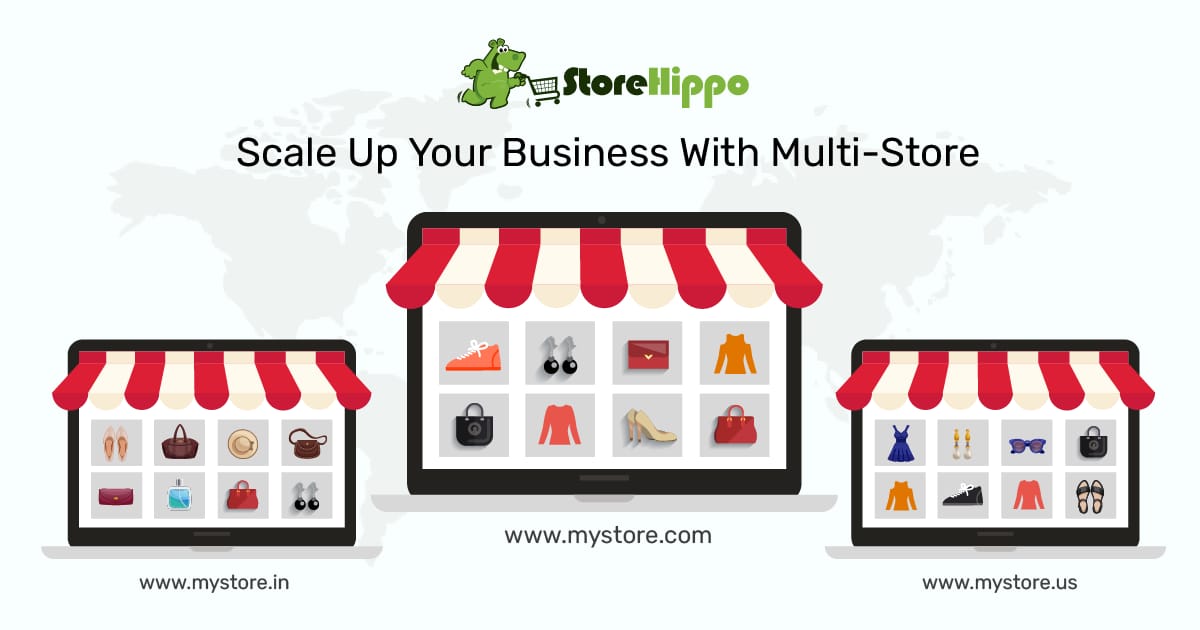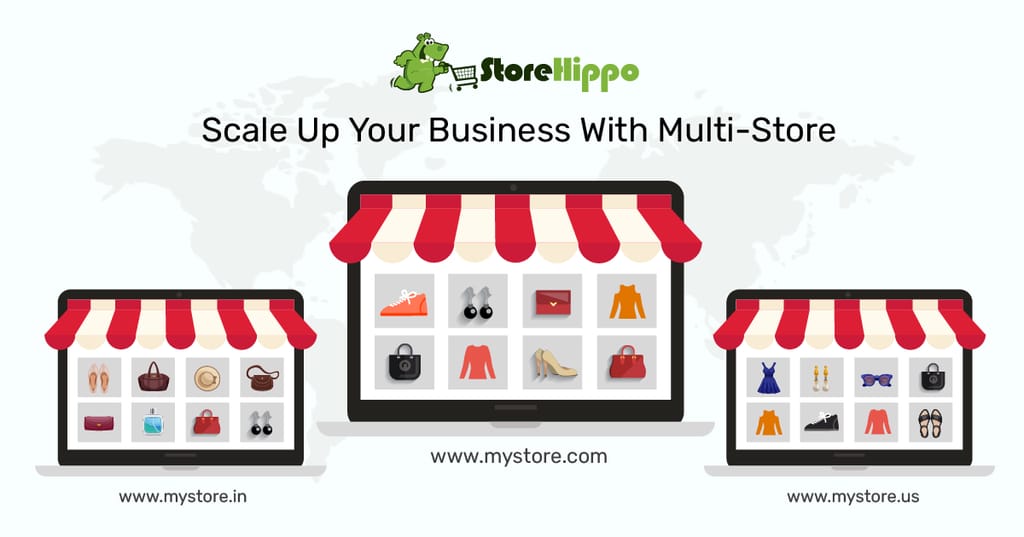Are you finding it difficult to engage and convert your online buyers? Want to build an online store that becomes the favourite shopping hub of your customers? Looking for ways to target interested customers without hurting your profit margins?
Not sure how to plan deals that actually engage your customers and set your cash counters ringing?
How about trying to target your customers with personalised deals on multi store ecommerce platform?
Wondering how can this setup work differently to your benefit?
Let’s start at the very beginning by understanding the setup first.
Table of Contents
What Is A Multi Store Ecommerce Platform Setup
As the name suggests, a multi store ecommerce setup lets you build, run and manage a network of online stores. These stores are customized as per the unique needs of the target markets and audience segment.
For easy management, these stores should be managed by a common central control/admin which allots unique inventory, deals, shipping, prices etc. for each of the location-specific stores.
For example, let us consider a chain of fruits and vegetable stores for different cities. Based on the local availability and demand, various multi-location online stores could be set up. Each of these city-based stores can have its own unique store design, inventory, prices, shipping providers or a custom fleet of delivery boys.
By creating multiple versions of the same store, each targeting a different set of customers, brands have a better chance of becoming the favourite shopping hub for any given location.
Multi Store Ecommerce Platform: Multiple Stores = Multiple Benefits
In this era of extreme personalization and me-tailing, building multiple storefronts has clear-cut advantages over having a single store. Check out how a multi store setup
Cater to specific needs of target audience and improve conversions
Diversify into various geographical locations
Create niche stores that help with powerful branding
Get a customized design that attracts and retains visitors
Offer product and prices based on targeted customer preferences
Target customers in their native language through multiple sub-stores
Offer location-based online payment or COD options
Offer regions specific logistics for your multi store ecommerce platform
Easy management of complete database with a common admin panel
Get better insight into traffic and conversions from multi-store Analytics and report
Allows targeted SEO and marketing strategy for each store
What Are The Use Cases Of Multi Store Ecommerce Platform
While any business can plan to roll out multiple storefronts as they grow some businesses have already used the setup to their advantages. Following are some examples of businesses that have used multi-location online stores to their advantage.
Grocery stores like Grofers offering unique inventory, pricing and hyperlocal delivery to tap the growing demand for online grocery
Vegetables and Fruits store like Bigbasket fulfilling vegetables, fruits, bakery and dairy products requirements by onboarding local vendors on location-based sub-stores
FMCG stores like Reliance Retail that merge offline and online buying experiences through their multi store ecommerce platform
Food Delivery business like Zomato, Swiggy etc. that offer location-based food delivery services to their customers via a multi-store multi-vendor model
Fashion stores like ASOS that have different sub-stores for different countries and offer seamless checkout in local currency
Diagnostics and Pathlabs multi store setup like Thyrocare that offers location-based diagnostics services through its offline path labs and multi-location online stores
Gifts and Flowers stores like Ferns N Petals that have a chain of stores in different cities of different countries
Electronics and Gadgets multi store ecommerce platform like Chroma with multi-location online and offline stores setup
Just like the above use cases, you can also build an innovative and disruptive solution for your online business. You can get started by building a chain of substores for different locations, audience segments or products. But to roll out and manage a large network of online stores you need a cutting edge multi store ecommerce solution like StoreHippo.
With StoreHippo you can quickly roll out any number of storefronts and manage them with a common central admin dashboard.
How To Target Customers With Multi Location Online Stores
Well, now that you can clearly see the advantages of multi-stores, it’s time to strategize your marketing to get the best ROI from this setup. After all, the customers are not going to flock to your stores just because you have rolled them out.
Not sure how to get started?
Here is a list of handy tips to help you solidify your presence in the local market
1. Create buyer personas
Based on the study of local markets and prepare each store to cater to these buyer segments/personas. For example, You have a grocery store. Suppose City A has more of a young population, so your multi store ecommerce solution catering to City A should offer more ready to cook meal packets, instant noodles etc. which is the staple for the younger lot.
By clubbing read-to-eat meals with other grocery items you can offer personalised offers that have a better chance to click with your young customers.
2. Analyse sales data
Take a detailed look into available data on the local buying habits and social practices. You can then accordingly plan your inventory and deals to give you better returns during the peak as well as slack sales season. For example, if you have location-specific data of customers from diverse ethnicity or from different regions of India, you can send out offers based on the unique festivals for each customer group.
This marketing strategy will also make your multi store ecommerce platform popular by word of mouth.
3. Product bundling
Use product bundling to your advantage by offering to boost your average order value by clubbing various products for a given location. Be careful to design your product bundles based on your analysis of your customers’ buying preferences. For example, If you have an apparel store you can bundle together apparel and accessories to create a look for a regional festival on store A while you can offer a totally different kind of product bundling on store B of your multi store ecommerce platform to cater to the regular office wear requirements of your customers.
4. Personalized promotions
Nothing works better than personalised deals. These deals could range from price discounts to free shipping and everything in between. Plan a variety of deals and discounts on each of your
location-based sub stores to attract various customer segments. For example, you can offer free shipping on a certain order value, offer additional 20% discount on bulk purchases for a certain product quantity etc.
5. Flash sale
Flash sale is a tried and tested way of engaging your customers. Combined with local weather, festival, any sudden changes in the sociopolitical environment you can plan limited time promotions to instantly boost your conversions. For example, if you are running a food delivery business and suddenly a city experiences rains. You can offer special discounts on foods that are in demand during the rainy season to boost sales of the store in that city/location.
While all these sales strategies can work wonders for your business you will need a feature-rich multi store ecommerce solution to implement these easily. StoreHippo offers an inbuilt solution to run a network of multiple stores from a common central admin. Along with this, you get a host of inbuilt marketing tools to run multi-level promotions. StoreHippo also offers integration with 60+ payment gateways to help you create hassle-free payment channels on all your sub-stores.
With StoreHippo’s integrated logistics solutions you can easily streamline your supply chain for timely and error-free deliveries.
StoreHippo’s Future-Ready Multi Store Ecommerce Solution For Your Business
Well, now that you are aware of the benefits of having a chain of stores for your business and how to promote them, you certainly need the best solution to power your business. Worry not, for you have StoreHippo multi store ecommerce solutions to take your business to new customers and markets.
Built grounds up on the mobile-first principle, StoreHippo creates PWA stores that can be accessed even on entry-level devices thus helping your business penetrate the vast untapped markets of tier 3 and beyond. You can also build separate mobile apps for each of your sub-stores and offer multilingual support in these apps to connect better with your customers.
Designed on the headless architecture, StoreHippo allows you to add multiple customer touchpoints and sell omnichannel without disturbing the backend logic of your multi store ecommerce platform.
The intuitive and easy to use common central admin allows you to set up different inventory, payment options, logistics and pricing for each of your sub-store. You can choose from the rich themes library and customize themes on each of the sub-stores using inbuilt drag and drop tools.
The fully integrated StoreHippo multi store ecommerce platform offers 120+ integrations to help you build innovative ecommerce systems for your business. Support for B2B, B2C, D2C, enterprise and custom business models allows you to experiment with a variety of business ideas.
Ready to rule the ecommerce market with your own multi location online stores? Explore 300+ features and cutting edge technology by starting your 14-day free trial right away!





















3 Comments
Leave a Reply
Leave a Reply
Leave a Reply